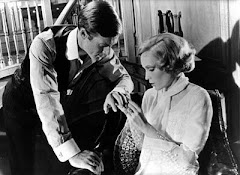
Gangsters are the modern-day urban Robin Hoods, the poor street urchin done good. The American dream of big dreams, individuality, and hard work can make something out of anyone. For many the fascination with gangsters really took off with the passage of prohibition  and the increasing media's attention on those men who decided it was more profitable to buck the system and get rich through their own means, than live by silly socially imposed rules. In the public eye, the gangster represents urban life: the streetwise, self-made man. In the 20's, New York and Chicago were the major capitalist urban hubs of American society and organized crime. Both were cities of stark contrasts between extreme wealth and abject poverty. For many in the early 1920's business was booming, and Al Capone and other famous gangsters and bootleggers ran their respective cities like puppet masters.(http://www.1920s-fashion-and-music.com/famous-gangsters.html)
and the increasing media's attention on those men who decided it was more profitable to buck the system and get rich through their own means, than live by silly socially imposed rules. In the public eye, the gangster represents urban life: the streetwise, self-made man. In the 20's, New York and Chicago were the major capitalist urban hubs of American society and organized crime. Both were cities of stark contrasts between extreme wealth and abject poverty. For many in the early 1920's business was booming, and Al Capone and other famous gangsters and bootleggers ran their respective cities like puppet masters.(http://www.1920s-fashion-and-music.com/famous-gangsters.html)
As street gangs, influenced by mobsters such as Capone, flourished during the 1920's and 30's  gangs became a symbol of lower income neighborhoods and ethnic ghettos. America's new immigrant communities and ghetto neighborhoods saw their youth forming gangs. African Americans, Asians and Hispanics made up the majority of street gangs that sociologists would research but the majority of all communities were experiencing street gangs in some degree. During the early 1940's, Mexican gangs formed along the west coast of the United States. Mobsters earned their money by providing illegal goods and services. They were most famous for bootlegging, but also managed gambling, prostitution, and abortion. While outlaws operated independently of mobsters, they did rely on organized gangs for the tools of the trade -- firearms, bulletproof vests, and armored cars. They could use the organized rings to pay for hide-outs and police protection. They could also arrange for legal assistance o
gangs became a symbol of lower income neighborhoods and ethnic ghettos. America's new immigrant communities and ghetto neighborhoods saw their youth forming gangs. African Americans, Asians and Hispanics made up the majority of street gangs that sociologists would research but the majority of all communities were experiencing street gangs in some degree. During the early 1940's, Mexican gangs formed along the west coast of the United States. Mobsters earned their money by providing illegal goods and services. They were most famous for bootlegging, but also managed gambling, prostitution, and abortion. While outlaws operated independently of mobsters, they did rely on organized gangs for the tools of the trade -- firearms, bulletproof vests, and armored cars. They could use the organized rings to pay for hide-outs and police protection. They could also arrange for legal assistance o r medical care. Whether outlaws were wounded in a gunfight or simply became ill, they risked capture by going to an ordinary doctor. For an exorbitant fee, an underworld doctor would treat them and not notify the authorities. The outlaws sometimes took on special jobs for the criminal rings, like murdering an enemy, that a particular organization wanted done but didn't want to take the blame for. (http://www.pbs.org/wgbh/amex/dillinger/peopleevents/p_gangsters.html)
r medical care. Whether outlaws were wounded in a gunfight or simply became ill, they risked capture by going to an ordinary doctor. For an exorbitant fee, an underworld doctor would treat them and not notify the authorities. The outlaws sometimes took on special jobs for the criminal rings, like murdering an enemy, that a particular organization wanted done but didn't want to take the blame for. (http://www.pbs.org/wgbh/amex/dillinger/peopleevents/p_gangsters.html)
Meyer Wolfsheim works with Gatsby in the business of bootlegging. Jay Gatsby spent a number of years trying to establish himself so that Daisy would approve of him. Little did he know that no matter how much money he made, she would never love him. He wasn't rich. Gatsby became a part of one of the largest money making endeavors of the 1920s. He became a bootlegger. The 18th Amendment was passed in the summer of 1919. As a result, sale and distribution of alcohol became illegal. The social climate of the era did not respond to this regulation. Many people became involved in an underground movement to sell and distribute alcoholic beverages. Through these illegal operations, Jay Gatsby was able to obtain enough money to purchase a home just across the bay from Daisy. His mysterious connections with Meyer Wolfshiem leave the reader with questions of the extent of Gatsby's involvement with the attempts to smuggle and consume alcohol in the 1920s.
approve of him. Little did he know that no matter how much money he made, she would never love him. He wasn't rich. Gatsby became a part of one of the largest money making endeavors of the 1920s. He became a bootlegger. The 18th Amendment was passed in the summer of 1919. As a result, sale and distribution of alcohol became illegal. The social climate of the era did not respond to this regulation. Many people became involved in an underground movement to sell and distribute alcoholic beverages. Through these illegal operations, Jay Gatsby was able to obtain enough money to purchase a home just across the bay from Daisy. His mysterious connections with Meyer Wolfshiem leave the reader with questions of the extent of Gatsby's involvement with the attempts to smuggle and consume alcohol in the 1920s.















Good post. Make sure to capitalize all names. 75/75
ReplyDelete